It wasn’t a
dream. It really happened. People looked that way, dressed that way
and played that way. Yes, the uniforms were that tight… and, oy,
those colors. Dan Epstein tells us so in his awesome book, Big
Hair and Plastic Grass: A Funky Ride Through Baseball and America in
the Swinging ‘70s.
A ride indeed, in
an AMC Gremlin over a road of potholes. Hang onto your seats. It’s
going to be a bumpy decade. Here, we talk with Dan about what it was
like stayin’ alive in the big leagues, gettin’ our turn at bat.
Major League
Baseball pretty much stayed the same during most of the twentieth
century, but in the 1970s, something happened.
It’s always been a conservative game, really. Even
now, to some degree, there is an element of conservatism to it. The
‘60s is when you really see how far apart baseball and pop culture
were. In the ‘70s, the bubble around the sport is pierced and you
start seeing players expressing themselves on the field.
Let’s start with
the obvious: those horrid new stadiums and the Astroturf.
The “concrete donuts” of the ‘70s were built to be
multipurpose stadiums. On one hand, it was an improvement over the
old stadiums, in a sense that there were no steel girders blocking
fans’ views, and the seats were wider and more comfortable. But
because of the way they were shaped, everybody was farther away from
the action. There wasn’t that sense of intimacy that you had at
Tiger Stadium or Fenway or Wrigley Field. Part of the multipurpose
function was the artificial turf [Astroturf]. It was easier than
pulling up the diamond and putting down the gridiron. It really
changed the way the game was played. The ball took much bigger and
faster hops. The teams that won on artificial turf did so by taking
advantage of that fact. If a line drive bounces correctly, it can be
an in-the-park home run.
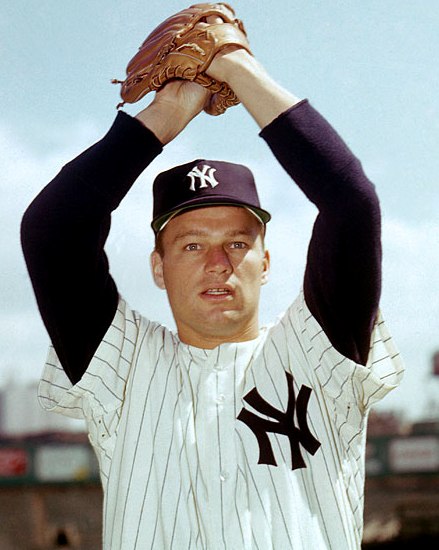 Jim Bouton’s 1970
blockbuster book,
Ball Four, was
an expose of baseball players, both on and off the field. Fans ate
it up, but it did not make a lot of players happy.
Jim Bouton’s 1970
blockbuster book,
Ball Four, was
an expose of baseball players, both on and off the field. Fans ate
it up, but it did not make a lot of players happy.
Ball Four
was pretty raunchy for a sports book at the time. It was a baseball
book about players chasing groupies, and the way players talked to
each other in an unvarnished way. It presented these guys as guys,
not these white-knight American idols. Just your average, horny,
foul-mouthed athletes. The Astros actually burned a copy of it in
their dugout. Pete Rose yelled at [author Jim Bouton], “Fuck you,
Shakespeare.” It’s like Bouton breached the clubhouse code. Up to
that point, what went on among ballplayers on the road was pretty
much unknown to the public.
These were not
the days of millionaire ballplayers, like today.
In the days before free agency, most of the
ballplayers were living a pretty much middle-class existence at
best. A lot of them were working odd jobs in the off-season to make
ends meet.
The
counter-culture revolution in baseball seems to have first sparked
with the Oakland A’s.
The whole explosion of long hair and mustaches
started with the 1972 Oakland A’s. This all happened because Reggie
Jackson came into spring training with a full beard. The team
actually had rules about grooming, but Reggie being Reggie, said,
“Fuck that. I’m going to wear this beard.” [The management] offered
to pay the rest of the team to grow mustaches and beards to steal
Reggie’s thunder. But the players found that they were playing
better with the mustaches on. Baseball players are a very
superstitious breed. The A’s were playing better together with the
facial hair. It was also a bonding thing. In 1972, their opponents
in The World Series were the Cincinnati Reds, who had really
stringent player grooming parameters. The media played it up: The
Hairs vs. The Squares World Series. The message: you can look like a
hippie and still play world champion baseball. After that, a lot of
teams started relaxing their restrictions.
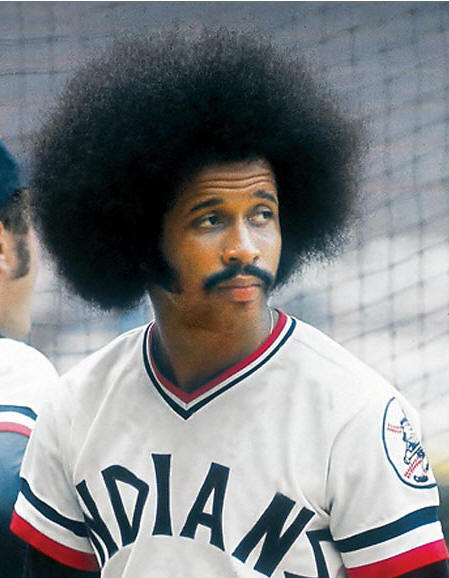 Relaxed indeed.
We’re talking about Afros, muttonchops, and porn ‘staches.
Relaxed indeed.
We’re talking about Afros, muttonchops, and porn ‘staches.
You can’t talk about ‘70s baseball hair without
talking about Oscar Gamble. He’s on the cover of the book for good
reason. He had the largest Afro ever seen on a major-league player.
There were plans for him to do an Afro Sheen commercial. There were
a lot of white guys wearing essentially perms: Mike Schmidt, John
Montefusco, Randy Jones, Mark Fidrych of the Tigers. That was no
perm – that was actually his hair. Dock Ellis was spotted in the
Pirates’ bullpen wearing pink curlers in his hair. Joe Pepitone was
a special case. That was a wig. In the ‘60s, he was the first ball
player to bring his own hair dryer into the locker room. He bought
these special toupees, for on the field and off the field.
The uniforms of
the ‘70s had a special, uh, uniqueness.
That was such a colorful period for uniforms. The
Houston Astros had Tequila Sunrise stripes. You could make an
argument that that was the ugliest uniform ever worn. On the other
hand, you can make the argument that that was the most awesome
uniform ever worn. I have a soft spot for the Chicago Cubs pajamas.
They were baby blue with white pinstripes. It was a combination that
no one ever used before or after. They were really hideous,
especially with the elastic waistband. For three days in 1976, the
White Sox went out on the field wearing shorts. It never happened in
the majors before or since. It’s so badly scarred in White Sox fans’
minds that to this day a lot of them believe that they wore shorts
all season.
Stadium
promotions of the ‘70s had a special air of desperation about them.
Promotions in baseball stadiums [prior to the ‘70s]
were limited to Ladies’ Day or Family Day. [White Sox owner] Bill
Veeck was the first to try to pull in people with giveaways and
lotteries, anything that would get some press and get people into
the ballpark. It was really frowned upon by most of the other
owners. The ‘70s had some of the most successful seasons in terms of
attendance. But the NFL was becoming much more popular. The NBA
hadn’t yet elevated itself to the point that it would be in the
‘80s. Baseball was no longer the big sport in America. They were
being challenged by other sports. You had to give people some kind
of reason to show up.
Even if it meant
witnessing a streaker running naked across the field.
Well, you can’t talk about the ‘70s without talking
about streaking. It hit critical mass around 1974. That was the
famous Chicago White Sox opening day where it was 38 degrees but you
have all these streakers running across the field at Comiskey Park
between pitches and that got the crowd riled up. At any sporting
event in the mid-‘70s, chances are you were going to see a streaker
at some point. It went along with the whole ‘70s “do your own thing”
and the body beautiful and the throwing off of the conservative
shackles. And it was always good for a laugh.
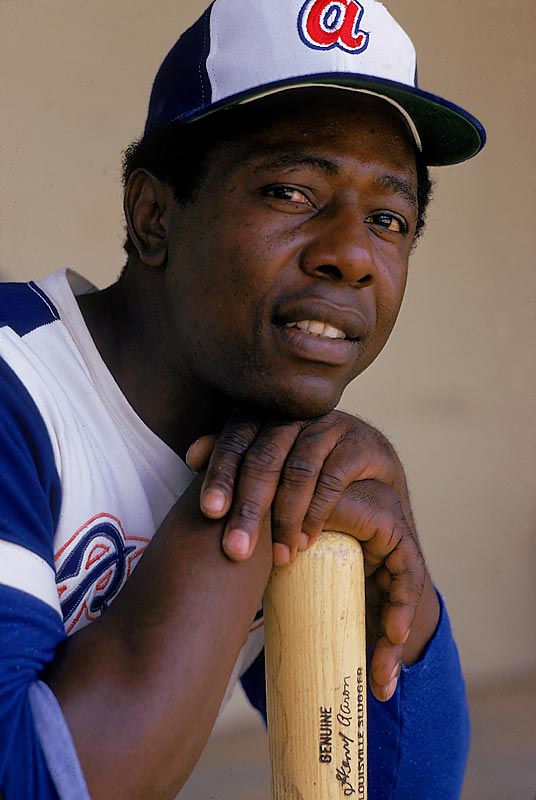 The Atlanta
Braves’ Hank Aaron, an African American, beat Babe Ruth’s home-run
record in the ‘70s, but many people were not enlightened enough to
accept it.
The Atlanta
Braves’ Hank Aaron, an African American, beat Babe Ruth’s home-run
record in the ‘70s, but many people were not enlightened enough to
accept it.
It looked like he was going to break the record in
1973, and that’s when he got the bulk of the hate mail. The notion
that a black man would be breaking Babe Ruth’s record, which stood
for about 40 years at that point, really didn’t sit too well. By
1974, it was obvious that he was going to do it and there was a lot
of anticipation.
Sports marketing
was in its awkward infancy in the ‘70s. It was not the
sophisticated, sleek machine it is today.
Nobody really knew what they were doing. Pete Rose
for instance: not a particularly attractive man, not a man I would
think people would look to for grooming tips, shilling for Aqua
Velva. There were oddball things like the “Johnny Bench Batter Up,”
which was a hitting aid for kids. It didn’t really work unless you
poured your own cement base for it. You had to go down to the
hardware store and buy a sack of cement.
There were also
teams recording pop songs and those records were getting airplay and
hitting The Top 40.
That goes back to the Sixties. The 1969 Cubs were
one of the first with a record called “Pennant Fever.” Several
members of the team sang about how they were going to go all the way
in ’69, which of course did not happen. The Phillies had “Phillies
Fever” in 1976, recorded by five players. That’s actually my
favorite one of the era. It’s sort of a disco song and it has
low-budget “Sound of Philadelphia” strings, which is very
appropriate for the period and the geographical location. And they
bring CB radio lingo in at one point: “The Phillies are gonna go all
the way, good buddy. 10-4.” It’s a terrible record, but I love it.
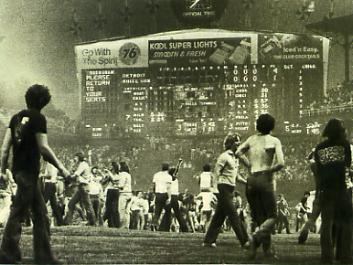 It seemed like
the end of the decade came with Disco Demolition Night at Comiskey
Park in 1979. It was one of the all-time great fiascos.
It seemed like
the end of the decade came with Disco Demolition Night at Comiskey
Park in 1979. It was one of the all-time great fiascos.
That was one of those promotions that we can all
agree that it got out of hand. But beyond that, opinions are widely
varied. A local DJ, Steve Dahl, really beat the drum for “Disco
Sucks.” The whole anti-disco movement really caught fire in the
mid-‘70s. Disco probably reached its cultural and artistic high
point around the time of Saturday Night Fever (1977). After
that, it really became “product.” The Top 40 was completely gutted
with disco music. The disco backlash manifested itself in the
anti-disco night at Comiskey Park. Not even Steve Dahl knew how
popular this event was going to be. I think they expected to draw
maybe an extra 20,000 at best, for a really awful White Sox team.
And this was a team that was putting on promotions all summer and
not really drawing people. But the place completely sold out.
You bring a disco record to the stadium to be
destroyed and you would get in for 98 cents. People are coming just
to party. Most are not even getting into the ballpark; they’re just
hanging out and smoking weed and getting wasted. So many people were
bringing in disco records that after a while, ushers stopped taking
them from people. People are so jazzed by [the record pile being
blown up] that they start running out onto the field. It just
destroyed the field. The second game of the double-header had to be
forfeited. In some ways, this is a black mark. It’s ‘70s baseball
promotions gone awry. At the same time, for a whole generation of
Chicago kids, this was one of the fondest touchstones. It was a
moment of anarchy and liberation. The meaning of disco demolition
will be debated until the end of time, but it was definitely a
pretty colorful way to end the ‘70s.
You mention in
your book that baseball looked very different in 1979 than it did in
1970.
Oh, yeah, and not just the grooming and the
uniforms. The designated hitter was introduced in 1973, and by 1976,
it’s in the World Series. Also, the players’ salaries [rose], when
the reserve clause was finally banished in 1976. They hold the very
first free agent re-entry draft. Suddenly, players are signing for a
million dollars over ten years, which now sounds like chump change,
but for baseball players then, this was huge. The whole salary
structure gets massively overhauled by the end of the ‘70s. This is
not just adjusting for inflation. This changes the way teams are
constructed. It drives “mom and pop shops” out of the business
entirely.
Was the thrill
gone by the ’80s?
It was for me. I checked out of my baseball
obsession around 1985 and didn’t come back until the Sosa/McGwire
home run chase in 1998. That whole period in between is just a blank
to me. The baseball strike in 1981 took a lot of the wind out of my
sails.
Ultimately, how
do you sum up the uniqueness of ‘70s baseball?
The ‘70s was this era where you can’t separate
baseball from what was happening in the country. That’s one of the
things I love about ‘70s baseball.
Double-play! Dan Epstein’s first book about ‘70s baseball,
Big Hair and Plastic Grass,
captured the pastime the way it used to be played back in the day
game, as well as capturing the zeitgeist of a nation in turmoil and
transition (two words: polyester). In the course of his research for
that book, Dan discovered the historic awesomeness of the 1976
season in particular. it seems the baseball happenings of that year
could fill more than a mere chapter.
The result: Stars &
Strikes, rounding home with a raw and righteous/outa
sighteous season of high drama (comedy too). We celebrate the
nation’s bicentennial while striking out Nixon and Viet Nam. Disco
was not yet called foul, a quirky young man who resembled Big Bird
took flight, and the major leagues went Major League. Not
surprisingly, that was also the year of the gorgeously cynical The
Bad News Bears. America, finally feeling its oats again,
quoted that flick: You can take your apology and your trophy and
shove it up your ass! Just wait until next year!
Here, our good buddy Dan gives us a big 10-4 on the book
(it’s a hit!) while he catches us on the flip-flop.
Dan, why 1976?
Culturally, 1976 really appeals to me because it’s such a
transitional year in music, politics, and in the sense that America
was kicking loose the last vestiges of the Nixon administration, all
the rage and the paranoia and that whole bummer of the early ‘70s.
[The attitude was:] “That’s all behind us! Let’s put on our boogie
shoes and paint some fire hydrants red, white and blue and really
enjoy!” There was such a sense of hopefulness and togetherness that
I had not seen in my lifetime in this country. It was a moment of
“we’re all in this together.”
Yet the actual Bicentennial itself was ultimately a bit of a
letdown, right?
It was so hyped. There was such a glut of Bicentennial souvenirs
manufactured. None of them became valuable and most of them were not
very attractive. There was a real interest from Americans, but at
the same time, it was so over the top and so oversaturated, with
immense, lavish, over-the-top celebrations. By the time July Fourth
actually showed up, I think people were ready to let it go.
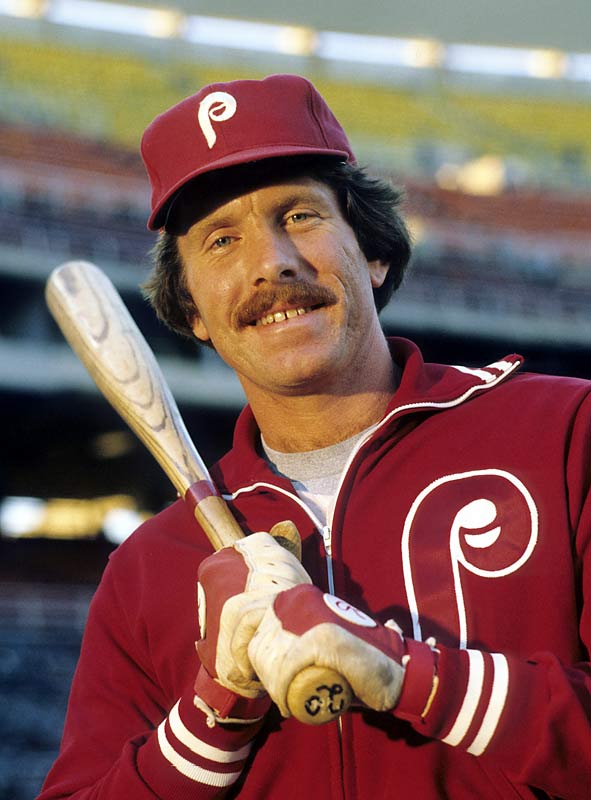 What was the team to watch that season?
What was the team to watch that season?
The team to watch was the Cincinnati Reds. They had already won the
1975 World Series, with basically the same group of guys. It was the
most intimidating lineup in baseball at the time. It was pretty much
a foregone conclusion that they were going to come close if not
totally repeat their success. The Philadelphia Phillies were not in
post-season since 1950, but yet, in time for the Bicentennial, they
got it together. It really came together for them that year. The
Kansas City Royals made the playoffs for the first time in their
history. They were an expansion team in ’69.
The New York Yankees had not been to a World Series since 1964. They
had a lot of pretty dismal seasons, and George Steinbrenner came
back after being banished from baseball for two years, along with
Billy Martin. They were great right out of the gate. It’s
interesting that the Yankees became great at a time when the whole
country was ready to write off New York City. They become a huge
source of pride for the city. A comeback.
The breakout star of 1976 was Mark Fidrych, nicknamed “The Bird.”
His story sounds like fiction, except for the fact that it was all
true.
The Tigers were not entirely sure what to do with him. They knew he
was very good. From Opening Day until the middle of May, he only
gets into two games. Another pitcher gets sick, and he gets to be a
starting pitcher. It’s right out of a Hollywood script. He pitches
phenomenally well. Not only is he a great pitcher, he is very quirky
and charismatic. He is talking to the baseball, and he’s dropping to
the mound to smooth out the cleat marks that other pitchers have
left, shaking the hands of his infielders every time they make a
good play.
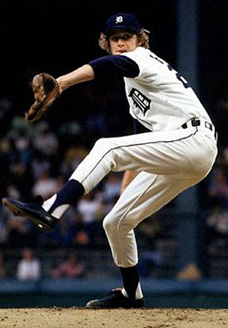 There is a pure joy that is radiating from him. That was a big part
of his appeal. It was a time of free agency and players demanding
more money and not being loyal to their team, and here is this guy
who looks like a 6’3” Little Leaguer. He’s just completely stoked to
be out there. He’s playing for the rookie minimum [salary]. By the
end of June, he is a national phenomenon. Yet he seems to be
unphased by it. He’s not cynical or super flamboyant. He’s not
boastful. He just loves to go out there and throw a ball. It
resonated very deeply with baseball fans and non-baseball fans
alike. He was like a rock star. 1976 was his lone full season. It
was this brief, beautiful moment, and then it was over. He didn’t
stick around the game. He just left and went back to Massachusetts
and bought himself a farm.
There is a pure joy that is radiating from him. That was a big part
of his appeal. It was a time of free agency and players demanding
more money and not being loyal to their team, and here is this guy
who looks like a 6’3” Little Leaguer. He’s just completely stoked to
be out there. He’s playing for the rookie minimum [salary]. By the
end of June, he is a national phenomenon. Yet he seems to be
unphased by it. He’s not cynical or super flamboyant. He’s not
boastful. He just loves to go out there and throw a ball. It
resonated very deeply with baseball fans and non-baseball fans
alike. He was like a rock star. 1976 was his lone full season. It
was this brief, beautiful moment, and then it was over. He didn’t
stick around the game. He just left and went back to Massachusetts
and bought himself a farm.
Team
owner Bill Veeck also continued to make waves as a colorful
character that year. How did he possibly top himself?
Veeck returned to Chicago at the end of ’75. He was a really beloved
character in Chicago. His return was a huge event. He was
gregarious, down to earth; he liked to sit in the stands and drink
with fans. He had an ashtray built into his wooden leg. This was not
your stereotypical, uptight, patrician team owner. When he bought
the White Sox, they were in a lot of trouble. They were a terrible
team and they were hemorrhaging money. They weren’t drawing anybody
to the park. Veeck realizes that he does not have a lot to work
with. So he comes up with all of these promotional ideas. This has
always been a big part of Bill Veeck’s game plan. He was a big one
for off-the-wall promotions, anything that would get some press
coverage.
He has beer-crate-stacking competitions, ethnic nights [his
ballplayers running out onto the field in sombreros for Mexican
Night], and giveaways. He was really the king of this stuff. He
designed a whole new uniform for the White Sox. They have collars.
He also designs Bermuda shorts. To this day, some fans believe that
the White Sox played an entire season or more in those shorts. They
were traumatized, like a false memory. In actuality, they only
played three games. The amazing thing is that the White Sox won two
of the three games that they played in shorts.
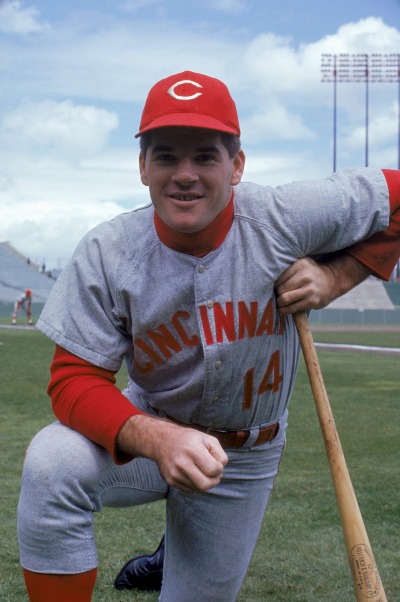 Pete Rose was another one to watch in ’76, as usual.
Pete Rose was another one to watch in ’76, as usual.
Pete Rose had a really good year in 1976. Pretty much every year in
the 70s, Pete Rose had a very good year. You can’t talk ‘70s
baseball without talking Pete Rose. The Reds just dominated the
Yankees in the World Series. Pete Rose was great at getting into
players’ heads.
What was the state of stadiums in ’76? A pretty sorry state, right?
1976 had an interesting mixture of ballparks. You still had the old
places like Tiger Stadium and Wrigley Field. Then you have the
concrete donuts that are covered in Astroturf, like Veterans Stadium
in Philadelphia and Royals Stadium in Kansas City. 1976 is the year
of the only rainout in Astrodome history! That’s one of my favorite
facts. There was terrible flash flooding in the area before a game.
Yankee Stadium comes back to life after two years of renovation.
They really change a lot of the character of it. San Francisco
nearly lost the Giants at the beginning of 1976. They were broke and
their owner was desperate to sell to anybody. The Giants had the
worst attendance in the National League. Part of the reason is that
Candlestick Park was a miserable location for a ballpark. They did
nothing to promote the games and nothing to encourage people to come
out. It also had a reputation for serving literally rotten food.
Ted Turner’s meteoric rise began that year too.
Ted Turner was a visionary in a way that nobody really understood at
the time. He was the owner of a UHF station in Atlanta that most of
the city couldn’t even pick up. These were the days before cable. He
has the idea of turning this UHF station into a satellite network
that could be beamed all over the country. He realizes that
broadcasting Braves games could be a big help with credibility. He
needed to keep his relationship with the Braves going in order to
expand his station.
The prevailing wisdom was not to televise too many games because you
want people to come out to the ballpark. Turner was doing just the
opposite. He had a much bigger goal in mind. Soon, there were Braves
fans all over the country. They were a terrible ball club, but
Turner made the stadium a happening place where people wanted to
come. What TBS eventually became changed baseball’s relationship
with television.
The biggest
change of the year is that players suddenly and finally got control
of their careers.
The reserve clause is revoked and now if players don’t sign a
contract with their team, they can play out their option and
negotiate with other teams and get paid whatever the market will
bear. The effect of this is mammoth. It will completely change the
way teams are built. It will completely change the economic
structure of the game. Everything we have today, from hyper-inflated
players’ salaries to the multi-billion-dollar cable deals, all come
from 1976. This is where it all starts.
How do you feel about this change?
I
don’t like what the game has become. I don’t like watching guys who
are multimillionaires playing while knowing that next year they will
not be on the same team. But if baseball is raking in the cash, then
players do deserve an equitable part of the pie. Up until 1976, they
weren’t getting that. I think that free agency was absolutely the
morally right path to go on, but it became a Frankenstein monster.
Email
us Let us know what you
think.